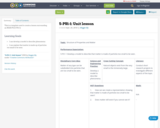
This is a template used to create a lesson surrounding an NGSS PE (5-PS1-1)
- Subject:
- Physical Science
- Material Type:
- Lesson
- Date Added:
- 06/20/2018

This is a template used to create a lesson surrounding an NGSS PE (5-PS1-1)
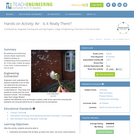
By watching and performing several simple experiments, students develop an understanding of the properties of air: it has mass, it takes up space, it can move, it exerts pressure, it can do work.

Children experiment with freezing water to observe a state change of water, and discover that it is less dense as a solid (ice) than it is as a liquid (water). Amazing Expanding Ice is an overnight activity requiring 20 minutes of preparation, overnight freezing of the experiment, and 10 minutes of follow-up discussion.

Ever wonder how honey gets from the bee to the table? Join the Bee Cause Project and avid beekeeper, Ted Dennard, on this immersive 360 video to find out just how those amazing bees do it! The National Honey Board has created an amazing look into the life of beekeepers and into the hive. We've created a lesson plan full of resources including science lessons, video links, and a full set of step-by-step printable cards for demonstrating the process of how honey is made!

Student groups compete to design a process that removes the most iron from fortified cereal. Students experiment with different materials using what they know about iron, magnets and forces to design the best process for removing iron from the cereal samples.

This video resource is presented as a real-world application of chemistry in the field of conservation archaeology. Conservator, Francis Lukezic, walks through the conservation practices for waterlogged archaeological wood and explains the chemical and cellular processes at work. Use to support Maryland/NGSS for Grades 5, MS, and HS. For 5-PS1-1 and MS-PS1-1, have students watch or perform the paper clip demonstration and discuss how the hydrogen bonding of water allows this then is disrupted by the soap; have students develop diagrams explaining the phenomenon of surface tension on the molecular level. For HS-PS2-6, have students watch or perform the sponge demonstration and discuss how the molecular structure of the wood makes it vulnerable to becoming waterlogged then brainstorm materials that are more resilient to water and discuss the uses of the materials. For interdisciplinary connections to geography and history, have students research why Maryland archaeologists do or do not discover the materials brainstormed instead of wood. If you evaluate or use this resource, please respond to this short (4 question) survey bit.ly/3DhRumA

This video resource is presented as a real-world application of chemistry in the field of archaeology. Conservator, Nichole Doub, walks through the process of electrolytic reduction and how it is used to conserve archaeologically recovered artifacts. Use to support Maryland/NGSS for grades 5, MS, and HS. For 5-PS1-1, pair with the Exploratorium's "Copper Caper" activity for a similar reaction which can be conducted safely in the classroom--have students watch the video and discuss why the spoon formed tarnish and why the tarnish was not visible as particles moved from the spoon to the sacrificial anode. For MS-PS1-1, pair with the Exploratorium's "Indicating Electrolysis" activity and have the students explain the charges of oxygen/hydrogen and compare/contrast those with the silver and sulfur in the tarnish. Have students research silver sulfide (the usual tarnish found on silver artifacts) and model a single molecule of it before and after electrolysis. For HS-PS1-1 have students research silver sulfide and model a molecule of it prior to watching the video and predict what will happen when the positive or negative charges change. For HS-PS2-6, have students postulate why, historically, coins were made from silver and gold (with reference to their chemical reactions), then have students design a coin and specify a different metal to make it out of, explaining why the atomic properties of that metal make it appropriate for use in currency. If you evaluate or use this resource, consider responding to this short (4 question) survey at bit.ly/3G0bNqy

Students will participate in a demonstration that will show the interconnectedness of a food web such that when one component is affected, the whole web is affected in some way. This is important for students to understand, as we are part of food webs and we need to be thoughtful about our decisions.
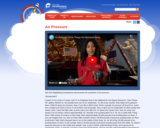
See how Magdeburg hemispheres demonstrate the properties of air pressure.
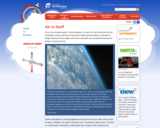
Learn about the properties of air and air pressure
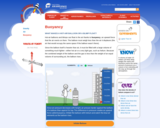
Learn how bouyancy makes a hot air balloon or blimp float.

Find out about two different types of drag: pressure and friction.

Design and fly your own airplane
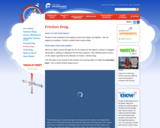
What is friction drag?

Without air, balloons and birds and airplanes couldn't fly. But since you can't taste, see, or often even feel air, how can you prove it's really there?
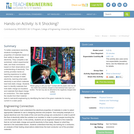
To better understand electricity, students investigate the properties of materials based on their ability to dispel static electricity. They complete a lab worksheet, collect experimental data, and draw conclusions based on their observations and understanding of electricity. The activity provides hands-on learning experience to safely explore the concept of static electricity, learning what static electricity is and which materials best hold static charge. Students learn to identify materials that hold static charge as insulators and materials that dispel charge as conductors. The class applies the results from their material tests to real-world engineering by identifying the best of the given materials for moving current in a solar panel.
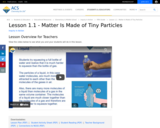
Grade 5 Chapter 1 - Matter is Made of Tiny Particles. Students squeeze a flexible plastic bottle filled with air and another filled with water to investigate the questions: Is an “empty” bottle really empty? and Can you force the molecules of a gas or a liquid to be closer together?
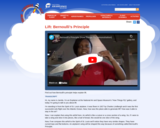
Find out how Bernoulli's principle helps explain lift.
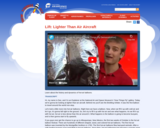
Learn about the history and dynamics of hot-air balloons.

Helium and hot-air balloons float in air, but how? Is floating a type of flying?